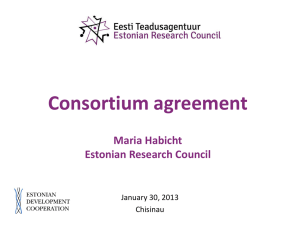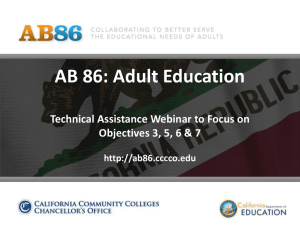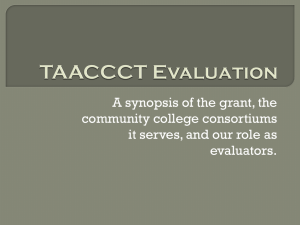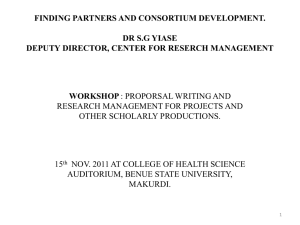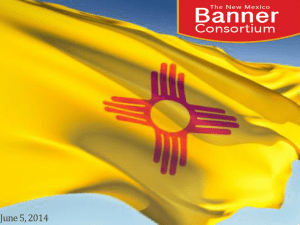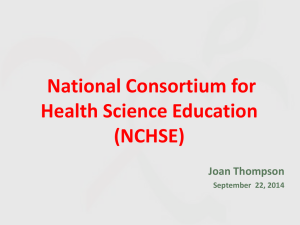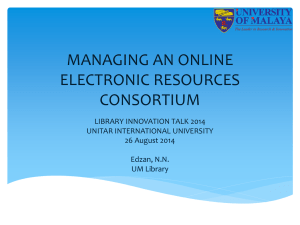Library Consortia
advertisement
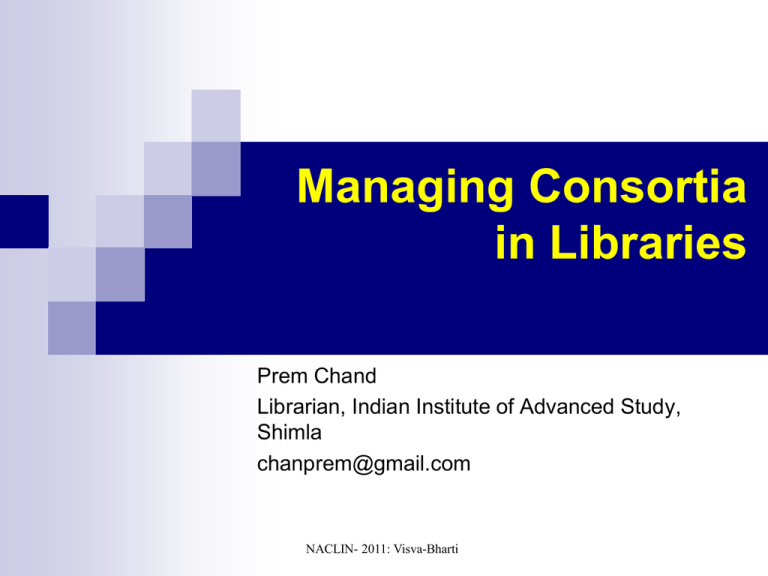
Managing Consortia in Libraries Prem Chand Librarian, Indian Institute of Advanced Study, Shimla chanprem@gmail.com NACLIN- 2011: Visva-Bharti Introduction • Library consortia • Need of Library Consortia • Benefits of Library Consortia • Governance , funding and operation • Types and model of Library Consortia • World wide Library consortia • Managing Library Consortia: Licensing and usage NACLIN- 2011: Visva-Bharti Library Consortia • A consortia is an association of two or more individuals, companies, organizations or governments (or any combination of these entities) with the objective of participating in a common activity or pooling their resources for achieving a common goal. • A library consortium is a group of two or more libraries that have agreed to cooperate with each other in order to fulfil certain similar needs, usually resource sharing. NACLIN- 2011: Visva-Bharti Library Consortia A group of libraries, preferably with some homogeneous characteristics by subject, or institutional affiliation, or affiliation to funding authorities, who join together with the primary objective of providing expanded access to information resources needed by its user community through a process of pooling and sharing information and infrastructure resources with due adherence to copyright compliances. It allows publishers to sell their e-journals in big packages to several institutions at the same time, reaching out to more institutions than they ever had before. NACLIN- 2011: Visva-Bharti Library Consortia • Consortia are also called as “Big Deal” • A Big Deal “may consist of hundreds of titles—often the publisher’s entire journals’ list—sold in a bundled package to a consortium of libraries on a one-price, one-size-fits-all basis,” according to Ingenta’s Mark Rowse in 2002. • First introduced by Academic Press (AP) in 1996, the Big Deal—in which publishers sell online subscriptions to large bundles of electronic journals—is now the principal means by which academics access research literature NACLIN- 2011: Visva-Bharti Why Library Consortia? Serial Crisis : • In 1990s Serial prices started rising, at about 10% per annum. • During that time, serials prices increased 10.8 per cent in 1995, 9.9% in 1996 and 10.3 % in 1997, eventually reaching 10.4 % in 1998. • Library budgets were struggling to keep up the subscription , and every time the price of a journal increased, a few more libraries cancelled their subscriptions. • This led publishers to increase prices further, which triggered another round of cancellations. • It was a vicious cycle that many felt threatened to destroy the 350-year-old scholarly publishing system. Why Library Consortia? • It was in the state of subscription spiral where library funding goes down and, consequently, prices go up, so subscriptions drop even further. • Budget cuts and price increase brought libraries into each others’ arms, and formed consortium . • Consortia based purchased was widely seen as a solution to the so-called serials crisis, and both publishers and librarians embraced it enthusiastically. • It is believed that consortium offers flexible pricing that offers researcher access to : Multi Journal, multiyear license access to electronic journals on cheaper price. NACLIN- 2011: Visva-Bharti Trends in scholarly communication Trends in Serial Publication and annual journal pricing: Over 23,700 journal titles are being published , and estimate of the global annual systemic cost is £174.6bn Elsevier, Springer and Wiley, publish 42% of journal articles It is estimated that some 1.59 million articles are currently produced globally each year, by roughly 1.92 million researchers Serial prices is increasing at about 10% per annum. NACLIN- 2011: Visva-Bharti Journal Pricing • Journals prices are currently growing by 6% to 7% per year. • Some journals cost $10,000 a year or more. The most expensive believed to be, Elsevier’s Biochimica et Biophysica Acta, is $20,930 • Discipline wise average Price of journals are: Chemistry Physics Engineering Business Sociology $3,429 $2,865 $820 $528 $2,071 NACLIN- 2011: Visva-Bharti Benefits • The cost-benefits are enormous. – Libraries world over have reported gains ranging from 70-90%. • Access to a greater number of journal titles and a stronger negotiating position through the purchase of a greater volume of content. • Indian consortia are a step ahead in their negotiation skills and have been able to secure gains up 96%. • Smaller institutions (historically unable to afford many journals), can have access to wide range of journals • Researcher and author also get benefit as consortia made it possible to expend greater potential readership. NACLIN- 2011: Visva-Bharti Benefits • Win -Win situation for both publishers and Libraries • Publishers continue to make very attractive profit. Elsevier, for instance, routinely reports profits of 30%-plus. In May, The Economist reported that, despite the recession, the company made £724m, an operating-profit margin of 36%. • Publishers claim that journals are currently growing in volume by 6% to 7% per year. As a consequence, prices must inevitably go up. • Libraries claim that there is a significant increase in access to full text journals. • Librarians argue that cost per download is low and it is getting lower. In 2003 in UK, the cost per article download averaged was £1.69 and five years ago the cost per article download was over eight pounds. • Cost of article of INFLIBNET consortium was Rs. 65.35 in 2009. it was 17.97 USD in 2004. Not everyone agrees! “The Big deal is the best invention since sliced bread. I agree that there was once a serial pricing problem; I have never denied there was a problem. But it was the Big Deal that solved it” Derk Haank, CEO, Springer NACLIN- 2011: Visva-Bharti The first ‘real’ library consortium? • In the late 1980s the first US state-wide consortium – OhioLink–was established. It received widespread attention as they were able to obtain additional state funding for their cooperative work. • A trend led by the U.S.-based OhioLink, the Ontario Academic Research Libraries (OARL) consortium in Canada, and the PICA group of universities in Germany and the Netherlands. • In Great Britain, Research Libraries UK ( RLUK ) later came to play a similar consortial role and signed agreement for 3 years with Academic Press (1996). NACLIN- 2011: Visva-Bharti . Continued…. • Importantly, other publishers also saw the logic of the consortia based subscription and rushed to introduce their own offerings. • In India: The first limited purpose and successful, consortialike model can be traced to Tata Institute of Fundamental Research (TIFR) in 2000 , which used the consortia model offered by Springer for multi-site licensing and cross sharing of content among all the libraries falling under TIFR’s affiliation • Today, a growing number of library consortia around the world had signed license agreement and are operational, ranging from small to big, and region and national consortia NACLIN- 2011: Visva-Bharti Governance, Funding, Operations and Management • The structure, membership, and funding of consortia vary largely from funding agency, participating members and subject disciplines. • National Steering Committee, Negotiation Committee, Review Committee and Working Groups are responsible for Licensing, purchasing, managing electronic resources and training. • Various Committee monitor, evaluate and review the NACLIN- 2011: Visva-Bharti consortium. Governance, Funding, Operations and Management • Negotiation committee members are from various other bigger consortium besides members from funding agency • Consortium negotiates and sign agreements on behalf of member libraries • One of the Institute is designated as a nodal centre for operation and implementation of consortium. • In India most of the consortiam are funded and supported by Government agencies. • In open ended consortia, participating libraries contribute for subscription of resources. • . NACLIN- 2011: Visva-Bharti Types and model of Consortia • Central Funded Consortium INDEST-AICTE Consortium CSIR E-Journals Consortium UGC Infonet Digital Library Consortium MCIT Consortium • Open Consortia and shared Budget FORSA IIM Libraries Consortium HELINET BJ Medical Library Consortium • Closed group CSIR/ DST , DRDO, DAE etc • National Consortium NACLIN- 2011: Visva-Bharti Consortia model in India • Indian consortium ranges from closed to open ended . Most of the consortia are central funded where member libraries don’t contribute. • UGC INFONET Digital Library Consortia: • ILL through JCCC • Print independent + print retention • Access to Elsevier Science : Retention of print clause • The universities have been provided the access to 1036 titles from 10 subject collections (Biochemistry, Genetics & Mol. Biology, Agriculture & Biological Science, Chemistry, Computer Science, Economics, Immunology & Microbiology, Mathematics, Physics & Astronomy, Social Sciences, Psychology) with access to back files since 1995. • Option for download 500 article annually to 60 universities from non subscribed journals • Member libraries can not discontinue print base. • Remaining universities can request for article under Document Delivery to INFLIBNET Chronology of Indian Consortium • COMSAC – (Consortium for Material Science and Aerospace Collection) is the first known formal consortia initiative led by the National Aerospace Laboratory (NAL) in 1998 for a few databases • Forum for Resource Sharing in Astronomy and Astrophysics (FORSA) • The first limited purpose and successful, consortia-like model can be traced to Tata Institute of Fundamental Research (TIFR) in 2000, which used the consortia model offered by Springer for multi-site licensing and cross sharing of content among all the libraries falling under TIFR’s affiliation. • The Council of Scientific and Industrial Research (CSIR) can take the credit being the first major and formal consortium at national level to sign license to access Elsevier journals in 2001 NACLIN- 2011: Visva-Bharti Chronology of Indian Consortium • Department of Automatic Energy (DAE) formed a consortium and signed up with Science Direct in 2002 • Indian National Digital Library in Engineering Sciences and Technology (INDEST) 2003 • HELINET (2003) • UGC-INFONET Digital Library Consortium 2004 • Recent developments : ICAR, NML, DST, MCIT, DRDO etc NACLIN- 2011: Visva-Bharti Sr no Name of Consortium Funding agency Members 1 UGC-INFONET Digital Library Consortium INFLIBNET Centre Universities 2 INDEST-AICTE Consortium MHRD/IIT, Delhi/ (48) institutions including IISc, IITs, NITs, IIMs ,1096 associate members 3 NKRC E-journal Consortium. (CSIR/ DST ) NISCAIR 40 CSIR and 26 DST institutes 4 DAE Consortium Department of Atomic Energy 36 institutions including BARC, TIFR and SAMEER 5 MCIT Library Consortium Ministry of Communications and Information Technology DIT, DOT, DOP and their related organizations and PSUs 6 IIM Consortium IIMs All IIMs NACLIN- 2011: Visva-Bharti Sr no Name of Consortium Funding agency Members 7 DRDO Consortium DESIDOC DRDO Labs 8 FORSA Consortium Indian Institute of Astrophysics 11 institutions including TIFR, PRL, IUCAA, etc 9 RGUHS-HELINET Consortium Rajiv Gandhi University of Health Science All the affiliated colleges of RGUHS 10 DeLCON Consortium Department of Biotechnology (DBT), 14 DBT Institutions including ICGEB, New Delhi and 18 North Eastern Region (NER) Institutions 11 ERMED Consortium National Medical Library 72 Government Medical Colleges/Institutes including ICMR affiliated research institutes NACLIN- 2011: Visva-Bharti Sr no Name of Consortium Funding agency Members 12 Consortium for E-resources in Agriculture (CeRA) Indian Council of Agriculture (ICAR) 123 agricultural / animal science Universities / Deemed Universities / Research Institutes of the Indian Council of Agriculture (ICAR) 13 N-LIST Consortium INFLIBNET Centre Govt aided / non aided Colleges NACLIN- 2011: Visva-Bharti World wide Library Consortium NACLIN- 2011: Visva-Bharti USA • Currently, there are roughly 215 consortia operating in U.S. These range from large/comprehensive to regional and small consortia. They are: GWLA (Greater Western Library Alliance) LYRASIS: Was formed by a merger of the regional consortia SOLINET (Southeast), NELINET (New England) and PALINET (Mid- Atlantic). The Consortium has more than 2,500 members CRL (Center for Research Libraries) • Small consortia: ALICE (Adventist Library Information Cooperative) FLO (Fenway Libraries Online) SWITCH (Southeastern Wisconsin Info Tech Exchange Library consortia in UK and other countries ICOLC members: 50 European consortia are operational (March 2011). Major among them are: Irish Research electronic Libraries (IReL) Scottish Digital Library Consortium (SDLC) The Swedish Consortium –BIBSAM Finnish National Electronic Library ( FinELIb) in Finland library consortia UK: Consortium of University Research Libraries (CURL) ,NESLI, SUPC , London Libraries Consortium,M25 Consortium of Academic Libraries - UK Academic Library Consortia China: China Academic Library and Information System (CALIS) NACLIN- 2011: Visva-Bharti Library consortia in UK and other countries • South Africa: • Cape Library Co-operative (CALICO), ESAL (Eastern Seaboard Association of Libraries), , FRELICO (FREe State Libraries and Information COnsortium , GAELIC (GAuteng and Environs LIbrary Consortium , SEALS (South Eastern Academic Libraries’ System, South African National Library and information Consortium (SANLiC) • Australia: • National & State Libraries Australasia (NSLA) EResources Consortium NACLIN- 2011: Visva-Bharti Managing the Consortia • Access to license materials • Usage statistics • Negotiation and Licensing • Funding • Promoting Use of E-Resources and Membership of the Consortium • Copyright and IPR Issue NACLIN- 2011: Visva-Bharti Access • The access to electronic resources is IP-enabled for member institutions (Multiple IP address, log in and password) • Access to entire journals file. with current and ten years back • Remote access via authentication: Ezproxy and Shibboleth NACLIN- 2011: Visva-Bharti Usage Statistics • Usage statistics is important to validate the library’s investment. It provides insights into usage patterns of journals used. • Usage data available can be used to assess the value of the journals. • ‘COUNTER’ compliant monthly, yearly or cumulative usage / statistics and send the usage statistics of member libraries to the agency responsible for implementation of the consortium. • The consortium should be given facility to extract the data from publisher’s site NACLIN- 2011: Visva-Bharti Sl. No. 1 2 3 4 5 6 7 8 9 10 11 12 13 14 15 16 17 18 Publishers 2007 2008 2009 2010 Increase in 2008 ACS AIP/APS AR Blackwell CUP Elsevier Emerald IOP 560506 302270 81533 278690 49304 95770 48776 134241 594960 336234 62528 121077 66745 155931 43480 168213 1031237 419658 76731 178869 72972 165029 69363 232573 1196487 377910 71637 526986 58165 181162 74499 249259 6.15 11.24 -23.31 -56.55 35.37 62.82 -10.86 25.31 73.33 24.81 22.71 47.73 9.33 5.83 59.53 38.26 16.02 -9.95 -6.64 194.62 -20.29 9.78 7.40 7.17 JSTOR Nature OUP PM Portland RSC 616560 42894 171952 46140 13706 134121 1382961 47996 198760 89975 13617 178676 1566952 79456 208692 89175 22294 185985 2140689 107648 304269 86094 220134 124.30 11.89 15.59 95.00 -0.65 33.22 13.30 65.55 5.00 -0.89 63.72 4.09 36.61 35.48 45.80 -3.46 -100.00 18.36 SpringerLink TandF Pr. Euclid SIAM 443024 134141 429 NS 977395 247849 551 828 1397193 293286 2124 1922 1501513 378814 2151 1643 120.62 84.77 28.44 NA 42.95 18.33 285.48 132.13 7.47 29.16 1.27 -14.52 Total 3153628 4686397 6089465 7475266 48.60 29.94 22.76 NACLIN- 2011: Visva-Bharti Increase in 2009 Increase in 2010 Average increase in download : 61.80 Economics of e-Consortium Publisher-wise Cost Recovery during 2009 Highest in JSOR followed by Springer and ACS Cost Recovery The total cost that has been recovered amounts to Rs. 4570 million as against the total expenditure of Rs. 410 millions with Rs. 4160 millions as the cost of articles downloaded in excess. Cost per downloads (Year-wise) Average cost per article Average cost is: 65.35. Increase in No. of Downloads from 2003 - 2006 (on Logarithmic Scale) 100000000 10000000 1000000 2003 100000 2004 2005 2006 10000 1000 Group I (IITs / IISc) Group II (NITs) Group III (IIITs) NACLIN- 2011: Visva-Bharti Group IV (IIMs) JCCC Licensing • Consortia licensing is a legal process of acquiring usage rights of the intellectual property governed by the copyright laws for a community of members. License should address following: • Publishers and consortium sign license agreement which is binding for both. The standard license agreement addresses following clauses: Authorized users Restriction of commercial use Course packs Electronic reserves Fees, Members, secure network, subscription period, usage rights , ILL and other terms and conditions etc. Licensing • Simultaneous Users: There should be no limit on number of simultaneous user on any of the resources subscribed by the Consortium. Any number of users can access e-resources including e-journals and bibliographic databases at any given time. • Walk-in Users: Walk-in users, physically present at the subscribing institute should also be allowed to use the resources NACLIN- 2011: Visva-Bharti Licensing • Inclusion of additional Titles The Licensor should provide access to new journal titles that are added during the contract period at no additional cost. • Electronic Link: Licensor should use suitable technology to establish electronic links to all the articles of licensed materials. • Print Copy of Journal: A print copy of the digital content should be kept as a backup of journals subscribed under the consortium • Perpetual Access and Archival Rights: In case of termination of the agreement or on the expiry of the agreement, licensor should extend perpetual access to e-resources for the paid period of subscription along with their back files offered during the subscription period Licensing • Print-independent Subscription: Subscription to e-resources should be print-independent. Discontinuation of print subscription which is available through consortium should not be binding to member Institutes. • Protection on Increase of Price: There should be no annual increase of the price. Annual increment of the price should be below 5%. • Inter Library Loan: Licensee should be allowed to fulfil ILL requests from nonauthorized users using (Arial software) electronic copy of article downloaded from the licensor’s Web site NACLIN- 2011: Visva-Bharti Funding • It is desirable that the consortia device innovative ways of generating and managing funding to sustain its activities. • Adequate funds must be set aside for consortium operations and management, which includes user education and training, development and deployment of technology and infrastructure to improve access to resources, etc. • Substantial funding is also imperative to subscribe to more e-resources, support uninterrupted subscription, and NACLIN- 2011: Visva-Bharti operational cost Conclusion • Study the usage pattern and identify the most used titles during last five years. It is estimated that 50% of titles have never been used. • An alternative scenario and possible future model is to explore user driven acquisition. • Explore other model , perhaps national consortium where negotiated can be done centrally by consortium and then the package could be purchased by Individual Institutions. • California state university is successfully piloting a scheme called “ get it Now” , a user driven document delivery scheme claims to deliver articles to users quickly. • The model is successful in California, there is no reason that why canuld’t be successful elsewhere. NACLIN- 2011: Visva-Bharti Conclusion • Study the total number of downloads from all the consortium explore and evolve the most used title-by-title jounal subscriptions supplemented and relying for the rest on document supply and interlibrary loans. • It is estimated that at least 10% of papers are now available on an OA basis. Out of Remaining 90 % we may require only 30%.Negotition should be done on only 30% most used journals. • National consortium It is need of the hour to have national consortium which should address the requirement of large population irrespective of affiliation. The model will overcome to duplicate subscription NACLIN- 2011: Visva-Bharti Thank you NACLIN- 2011: Visva-Bharti
